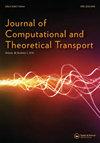Numerical Solution of the Azimuth-Dependent Fokker-Planck Equation in 1D Slab Geometry
IF 1.1
4区 工程技术
Q3 MATHEMATICS, APPLIED
Journal of Computational and Theoretical Transport
Pub Date : 2021-03-01
DOI:10.1080/23324309.2021.1896554
引用次数: 1
Abstract
Abstract This paper is devoted to solve the steady monoenergetic Fokker-Planck equation in the 1D slab when the incoming fluxes and the source term are allowed to depend on the azimuth θ. The problem is split into a collection of θ-independent problems for the Fourier coefficients of the full solution. The main difficulty is that, except for the zeroth Fourier coefficient, each of these problems contains an artificial absorption coefficient which is singular at the poles. Two numerical schemes capable of dealing with the singularities are proposed: one that is considered as the main scheme, and a second ‘security’ scheme which is used to verify that the results obtained by means of the first one are reliable. Numerical experiments showing second order of convergence are conducted and discussed.一维平板几何中方位相关Fokker-Planck方程的数值解
摘要本文致力于在允许入射通量和源项取决于方位角θ的情况下,求解一维平板中的稳定单能Fokker-Planck方程。该问题被分解为一组与θ无关的问题,这些问题的傅立叶系数为全解。主要的困难在于,除了第零傅立叶系数外,这些问题中的每一个都包含一个在极点奇异的人工吸收系数。提出了两种能够处理奇异性的数值格式:一种被认为是主格式,另一种“安全”格式用于验证通过第一种方法获得的结果是可靠的。进行了显示二阶收敛性的数值实验,并对其进行了讨论。
本文章由计算机程序翻译,如有差异,请以英文原文为准。
求助全文
约1分钟内获得全文
求助全文
来源期刊

Journal of Computational and Theoretical Transport
Mathematics-Mathematical Physics
CiteScore
1.30
自引率
0.00%
发文量
15
期刊介绍:
Emphasizing computational methods and theoretical studies, this unique journal invites articles on neutral-particle transport, kinetic theory, radiative transfer, charged-particle transport, and macroscopic transport phenomena. In addition, the journal encourages articles on uncertainty quantification related to these fields. Offering a range of information and research methodologies unavailable elsewhere, Journal of Computational and Theoretical Transport brings together closely related mathematical concepts and techniques to encourage a productive, interdisciplinary exchange of ideas.
 求助内容:
求助内容: 应助结果提醒方式:
应助结果提醒方式:


